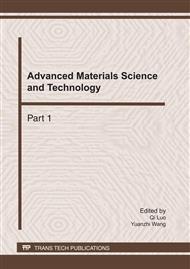[1]
Jolly M R, Bender J W, Carlson D J. Properties and applications of commercial Magnetorheological fluids[J]. Journal of Intelligent Material Systems and Structures, 2000, 10(11): 5-13.
DOI: 10.1177/1045389x9901000102
Google Scholar
[2]
Zheng Jun, Zhang Guanghui, Cao Xingjin. Analysis on the working principle of MRF transmission device[J], Journal of Chongqing University(Natural Science Edition ), 2007, 30(11): 19-22 (in Chinese).
Google Scholar
[3]
Kosuke Nagaya, Akihisa Suda, Hidenari Yoshida, et al. MR fluid viscous coupling and its torque delivery control[J]. Tribology International 40(2007): 89-97.
DOI: 10.1016/j.triboint.2006.02.059
Google Scholar
[4]
Kevin Molyet, Constantin Ciocanel, Hideki Yamamoto, Nagi Naganathan. Design and performance of a MR transfer Device[C]. 2005 ASME International Mechanical Engineering Congress and Exposition, Florida 2005, November 5-11: 1-7.
DOI: 10.1115/imece2005-81428
Google Scholar
[5]
Zheng Jun, Zhang Guanghui, Cao Xingjin. Flow analysis of magnetorheological fluid in transmission device in steady state[J]. J. Cent. South Univ. (Science and Technology), 2008, 39(1): 149-154(in Chinese).
Google Scholar
[6]
He Jianmin, Huang Jin, Zhong Yinhui. Viscoplastic flow of the MR fluid between two cylinders[J]. Journal of Functional Materials, 2006, 37(6): 992-993( in Chinese).
Google Scholar
[7]
Huang J, He J M, Zhang J Q. Viscoplastic flow of the MR fluid in cylindrical valve [J]. Key Engineering Materials, 2004, 274/276: 969-974.
DOI: 10.4028/www.scientific.net/kem.274-276.969
Google Scholar
[8]
Pan Sheng, Wu Jianyao, Hu Lin et al. Yield stress and Temperature effect of Magnetorheological fluids[J]. Journal of Functional Materials, 1997, 28(2): 264-267(in Chinese).
Google Scholar
[9]
Si Hu, Peng Xianghe. Roheogical effect for magnetorheological fluids[J]. Journal of Chongqing University, 2003, 26(5): 72-75(in Chinese).
Google Scholar
[10]
Wang Yufei, He Lin, Shan Shujun. The finite element analysis based on Maxwell for magnetic circuit design of MR damper[J]. Noise and Vibration Control, 2007(4): 28-32(in Chinese).
Google Scholar
[11]
Shan Huiyong, Yang Yanrong, Wei Yong. Analysis and design of a disk-shaped magnetorheological brake[J]. Machine Tool & Hydraulics, 2006(4): 53-55(in Chinese).
Google Scholar


